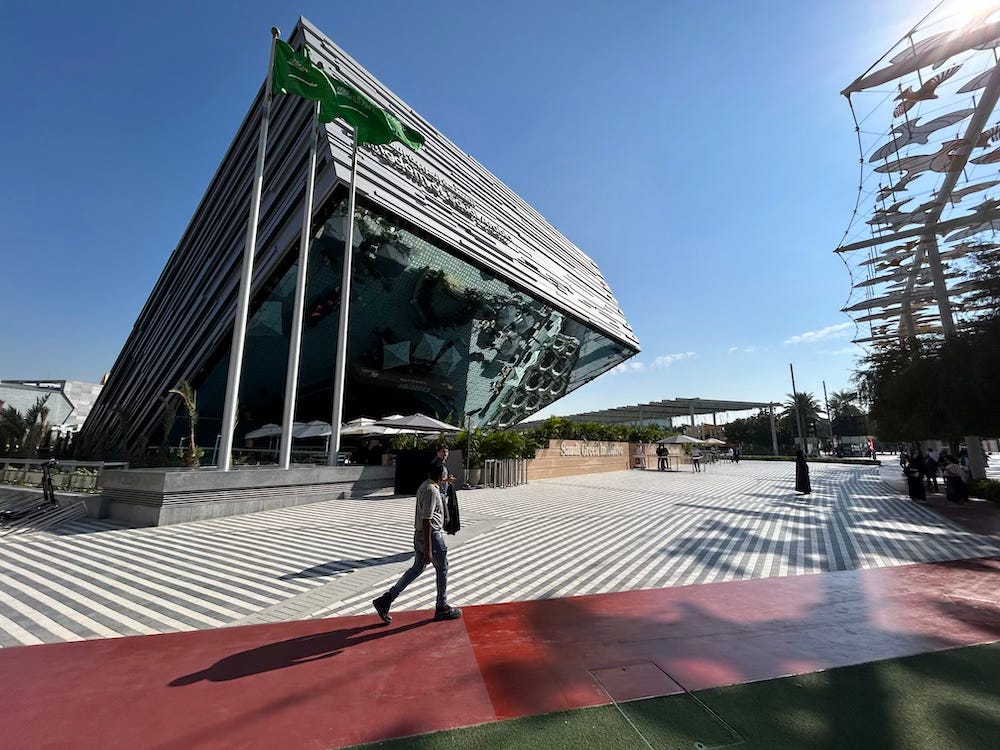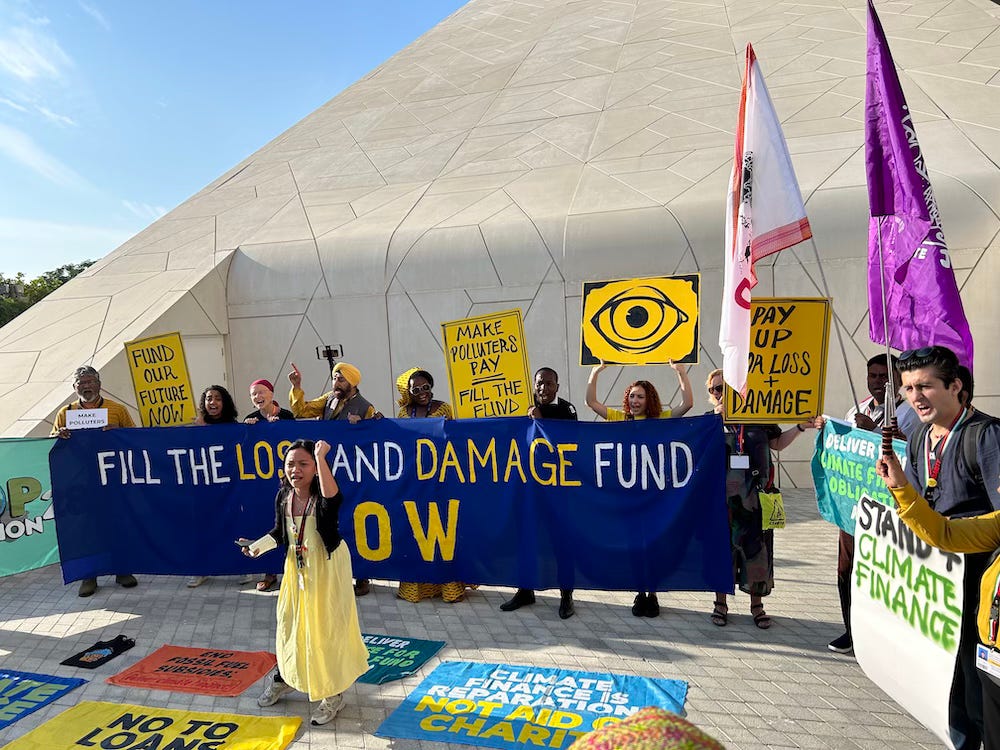Report from Dubai: A tussle over science belief while financiers gab
Good Evening from Dubai,
A lot happened today at COP28, much of it nothing to do with the stated theme of the day, “Climate Finance”. The COP president was caught denying climate science, tech guru turned climate financier Bill Gates said we’re not likely to even stay below 2°C, and investors batted around ideas to come up with trillions of dollars of annual investment for green energy projects that don’t have very sexy returns.
Oh yeah, and then the very weird Green Zone opened up today. As one friend with family in Dubai told me, “The Arabs really know how to spend their oil money.”
Let’s get into it.
-Mike

COP28’s fifth day started with a giant record scratch, as comments by COP28 President Sultan al Jaber denying that fossil fuels caused climate change swept across the conference. An intense blowback from climate activists forced Al Jaber to hold a snap presser to repeatedly declare he is a full believer in climate science.
“There is no science out there, or no scenario out there, that says that the phase-out of fossil fuel is what’s going to achieve 1.5°C,” said Al Jaber in a November webinar reported today by The Guardian.
Al Jaber avoided a regular morning Presidency press conference, leaving one of his underlings to be pummeled by reporter questions. Later, activists in other scheduled press conferences piled on.
“This speaks to the fact that we have a COP presidency that comes to the core issue with fossil fuels,” said Iskander Erzini Vernoit from E3G.
Lili Fuhr, director of finance from the Center International Environmental Law, expected Al Jaber would deflect, “We’ve been drowned with declarations and voluntary initiatives. We should not be distracted by a massive display of PR tactics.”
Then, in an attempt to put the issue behind him, Al Jaber staged an early afternoon presser, reeling off a list of COP28’s accomplishments thus far: Operationalization of the Loss and Damage Fund on the conference’s first day, $725 million committed to the fund thus far, a new $9 billion green energy fund from the World Bank, and many more bullet points.
Still, he juked around the key question: Are fossil fuels responsible for climate change?
“We fully understand the urgency behind this matter. We believe and respect the science,” he said multiple times in multiple ways. “I have a full understanding what is at stake.”
Pulled up before the press to provide bonafides for Al Jaber, the chief scientist of the International Panel on Climate Change Jim Skea weakly said, “I can say that Dr. Sultan has been attentive of the science.”
While Al Jaber’s comments upset activists and lend credibility to climate deniers who want to ignore climate change, it likely had little impact on negotiators, who continue to labor in meeting rooms a few hundred feet away from Al Jaber’s press conference. There, negotiating committees are closing out their first rounds of comments on negotiation texts, with many second drafts expected to start rolling out tomorrow.
Only then will we begin to know if COP28 is on the road to success.
One big issue
Today was Climate Finance Day at COP28, which brought more commitments from organizations to spend on green energy investment but also dozens of discussions among big investors about how to tackle climate finance. Unlike other climate talk fests, these conversations may actually bear fruit, since many of the problems of climate funding involve financial engineering problems, such as a dichotomy between the demand for green energy financing and the risk-reward balance.

Barbados’ Prime Minister Mia Mottley, who has been a global leader on changing finance opportunities for the developing world, has been pushing for changes to the way development banks assess the risk of developing world debt. “This has probably been the most progress we’ve seen on world finance, but we’re not where we need to be yet,” she said in a morning press conference. Next, she tallied a list of changes she’d like to see, such as expanded debt pause clauses for countries impacted by climate-fueled natural disasters, and a shift from evaluating debt capacity by GDP per capita, a metric not used for rich countries, and lending terms that could stretch as far as a century.
“There is no bank, no entity that will [lend] my country the equivalent of 20% of GDP over 20 years,” she said.
Mottley also pointed out that the $100 billion goal for the Loss and Damage Fund is too small, as current estimates are that over $300 billion a year will be needed. Fund needs to be decoupled from foreign aid budgets and given direct funding vehicles, she says, such as taxing aviation and shipping fuel and the finance industry. “If we add a global financial services tax at 0.1%, that would raise $420 billion,” she said. “If we took 5% oil and gas profits last year, that would give use $200 billion.”
The need for developing country green energy finance is staggering, as a study from London School of Economics’ Lord Nicholas Stern found that developing countries will need $2.4 trillion annually to get to the 1.5°C target.
“The world needs to change the global perspective of finance,” said Mottley. “The destination is not finance, it is the execution of actual projects.”
“Development banks need to step up their game, the amount of climate financing decreased last year,” World Wildlife Fund’s global finance lead Aaron Vermuelen told me in a separate interview. “There’s not enough [projects] for the private sector to invest in emerging markets. The financial risks are too high. Governments and development banks need to step up. Private companies are scared away and they don’t have the patience.”
Specifically, Vermuelen says governments and development banks need to syndicate green energy financing by taking subordinate positions – in other words, they might put together a $100 million deal but promise to let private banks get paid back first, putting the majority of the risk on themselves. In that circumstance, a development bank might only need to put up 50% of the entire deal, pulling in private finance that require a lower risk profile for the rest of the deal.
Vermuelen also says investors that aren’t getting into green investment now are setting themselves up for long term loss. “There’s physical risk, due to fires, floods, natural disasters, but also transition risk,” by not paying attention to green investment, since normal investment vehicles are increasingly exposed.
“All the regional development banks are getting involved in this sector,” he said, referring to the African Development Bank and the Inter-American Development Bank. “But there’s not nearly enough scale.”
What I did today

While COP28’s Blue Zone, operated by the U.N. for negotiators and delegates, is about two square miles, the Green Zone, operated by the U.A.E. and about twice the size, opened today. I took a brief tour this morning and was frankly gobsmacked by the size and grandiosity of the facilities, which more closely resemble a billionaire’s trade show than anything else.
Numerous oil states operate galactic-sized permanent buildings stocked with self-aggrandizing promotional material and local Gulf companies fill buildings with huge labels like “CLIMATE FINANCE” across the side. This morning the buildings were stocked with wealthy Emiratis hobnobbing among high-end booths built for the conference by banks and local industry.
The Green Zone is open, and free to anyone who wants to come, although you need to request a ticket in advance, so the U.A.E. can easily control who comes in – such as potential protestors.
I ducked in the “U.A.E. House of Sustainability” which was actually a very beautiful emporium of exhibits showcasing the country’s brisk 52-year move from a poor desert country to a wealthy, highly literate nation. A few exhibits were jammed in about sustainability. Nowhere was the fact that the country’s transmogrification was powered by fossil fuels and foreign labor.

I also saw my first protest this morning, as a group of indigent leaders called for fully funding the Loss and Damage Fund. While the protestors were surrounded by cameras (only a few were legitimate press outlets) delegates and negotiators streamed by, barely paying attention to the protestor’s chants. It must be depressing work to be a COP protestor.





